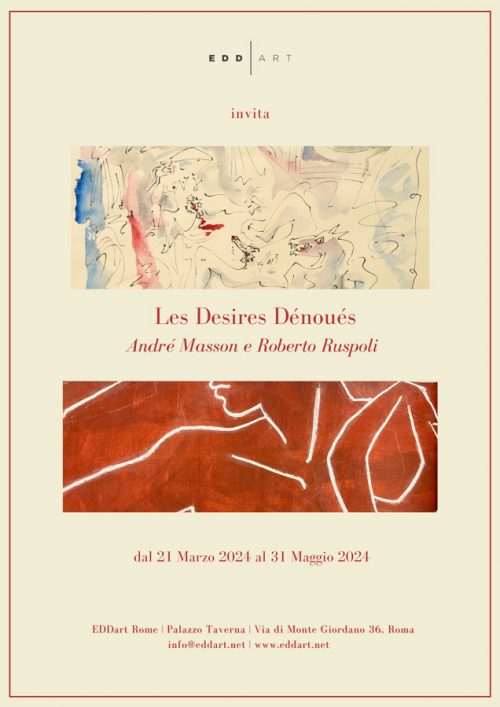Les Desires Dénoués André Masson e Roberto Ruspoli
Opening: Wednesday, March 20th from 6 pm to 9 pm
Venue: EDDart | Palazzo Taverna, Via di Monte Giordano 36, 00186 | Rome
Open to the public: from March 21st to May 31st
Hour: From Tuesday to Saturday, from 11 am to 7 pm or by appointment
“Les Désirs Dénoués” is an exhibition that revolves around a skillful collection of works by the great surrealist André Masson (1896-1987), in dialogue with one of the latest series of drawings by Roberto Ruspoli (1972), an Italian artist residing in Paris who works within the French tradition.
From André Masson, one of the most prominent French artists, to whom the Centre Pompidou in Metz is currently dedicating a comprehensive retrospective, we exhibit a heterogeneous body of works capable of shedding light on various interests through the use of drawing. This tool proved to be fundamental, especially during the many tumultuous phases of his life.
Primarily during wars: the First World War, in which he participated, left an indelible mark on him. He often reworked the trauma of violence in a lyrical calligraphy. Then, during the Spanish Civil War, he decided to return to France, to Normandy, but by then all of Europe was on the brink of abyss, and despite being convinced not to leave the old continent, he moved with much of the Surrealist group to the United States.
During these phases of continuous movement, drawing was Masson’s only form of expression, but even upon his return to France after the American period, so laden with consequences, it remained his primary mode of expression. Capable of conveying the cornerstones of his poetics: the elaboration of wartime violence, erotic impulse, lyrical abstraction, graphic design, and theater. Cornerstones that we have sought to represent in the exhibition through works such as “Les Séquestres d’Altona” or “The Legend of the Golden Ass” (1960).
For Roberto Ruspoli as well, drawing is a primary language of expression, which fits into the French tradition of the 20th century in terms of formal quality and inspiration, with a gaze directed towards both Greek classicism and the elegance of Japanese art. “My work fits into the French tradition of line as immediate and poetic spontaneous expression, but drawing inspiration from classical roots,” says the artist. “So drawing is a form of unraveled writing (dénouée); the draftsman merely takes the line that writing knots in order to create words, phrases, meaning; he untangles it to recompose it into a stroke that possesses a synthetic value that writing does not have.”

